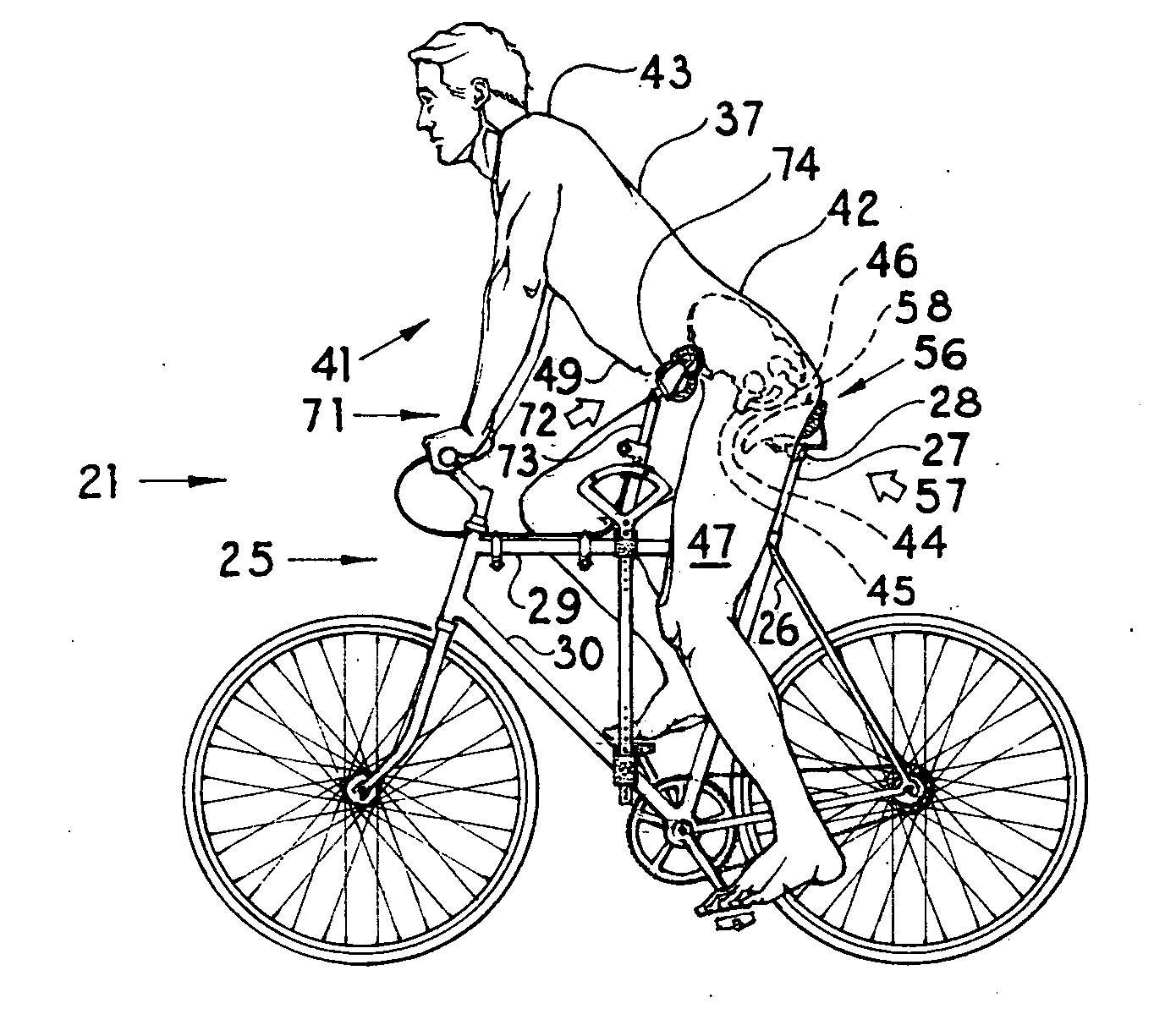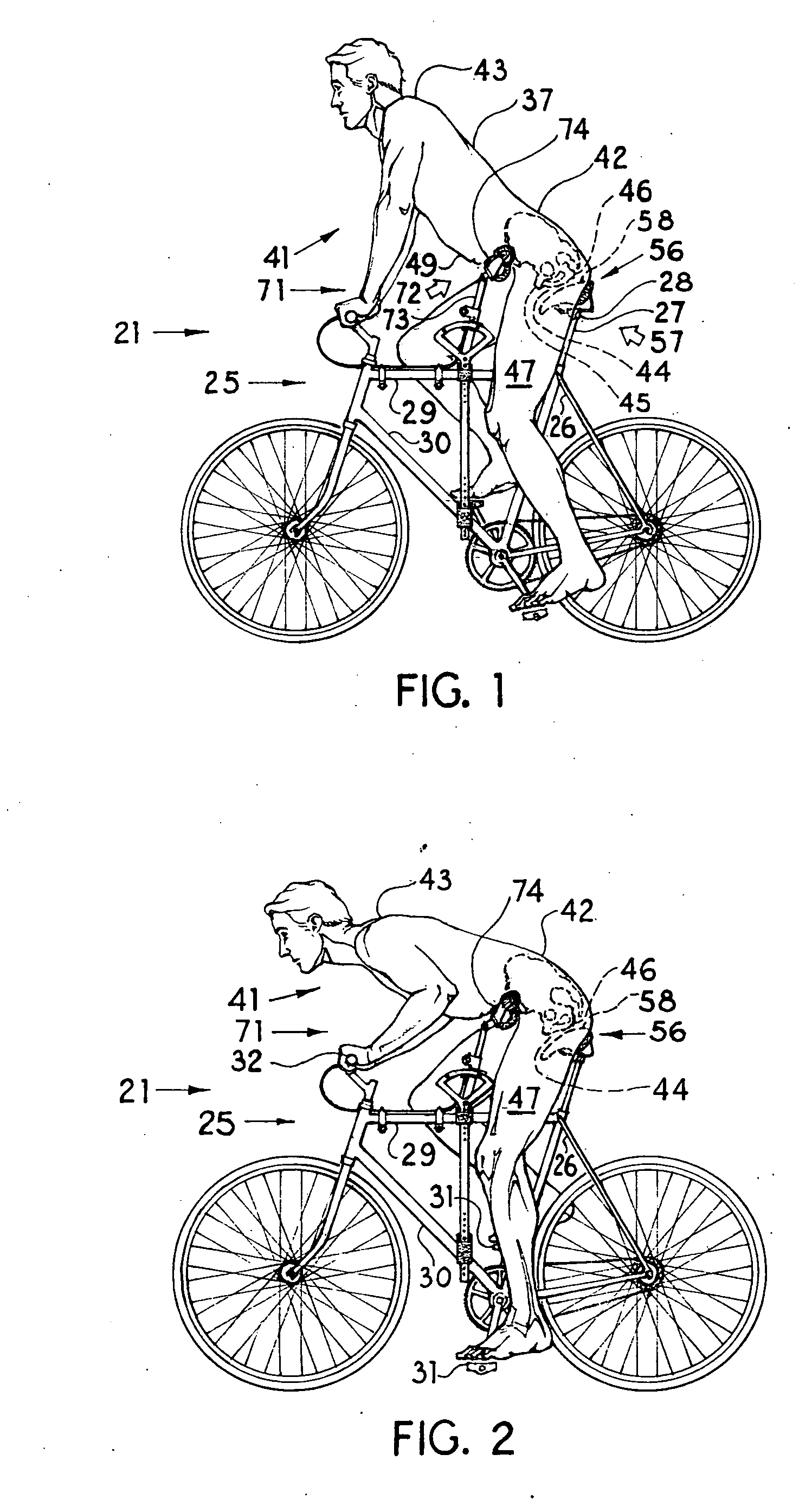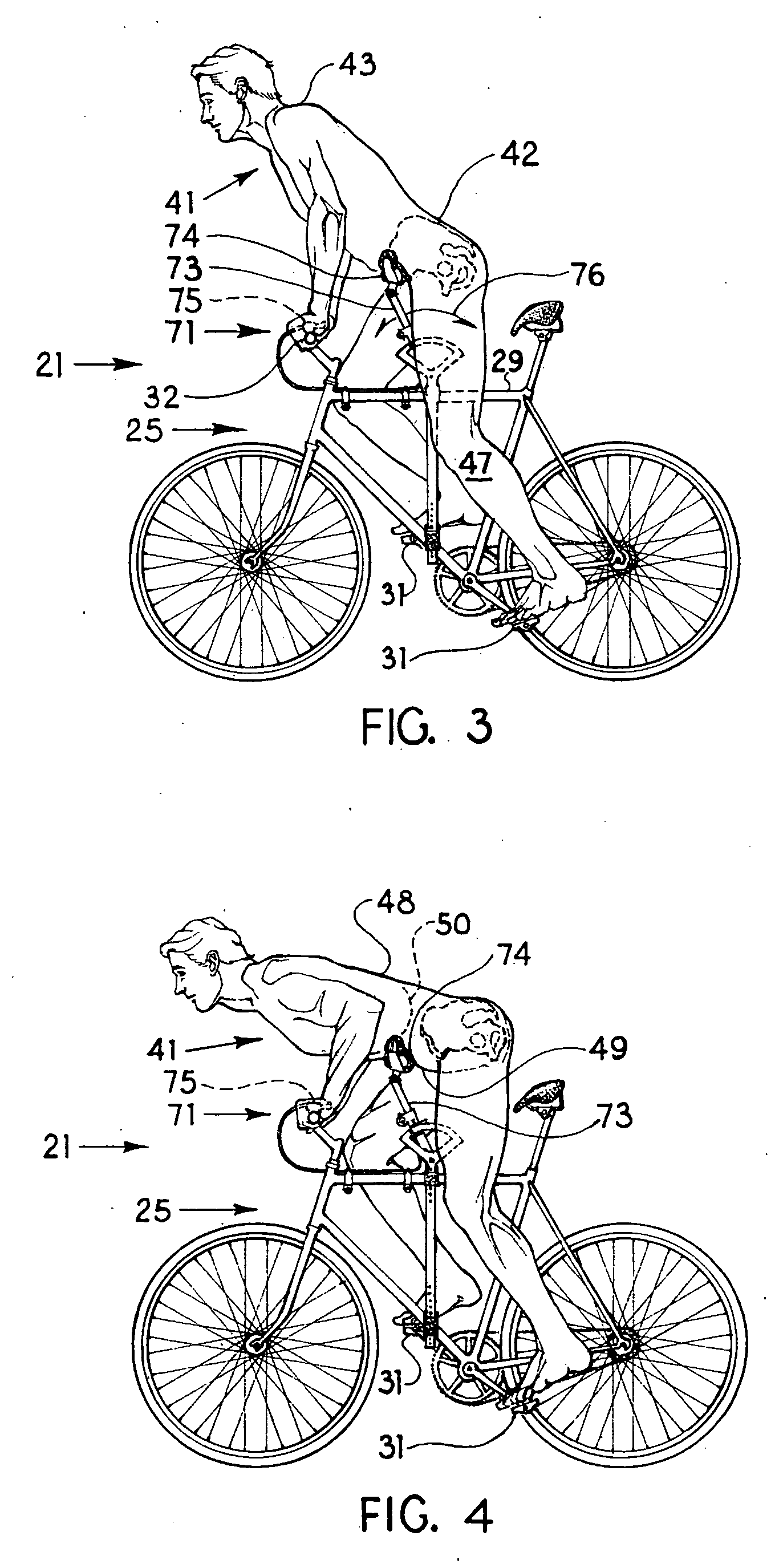[0029] The present embodiment of the invention solves the difficulty of providing
cycling seating, which seating combines improvements of both comfort and utility over the prior art of the field. The present invention of a seating
system results from a refinement in the understanding of a cyclist's need for body support when a cyclist is engaged in the movements required to operate a
cycling vehicle. The present invention provides support for a cyclist in two seperate locations on the body of the cyclist. One surface of support contacts the inferior posterior area of the hips of a cyclist. The second supporting surface contacts the cyclist along a band of support across the anterior face of a cyclist's
waist. The combination of both posterior and anterior support holds the body of a cyclist in a stable position, without the need for a weight-
bearing surface to be placed between the legs of a cyclist.
[0033] The
assembly of parts for the anterior support device are herein described, beginning with the concave waist support. The anterior support device is held in place by an
assembly of adjustable parts, which parts are connected to the cross bars of the frame of a bicycle. The surfaces of the concave waist support are held together by a waist support plate, which plate extends across the width of a cyclist's hips. The waist support plate allows for the adjustable positioning of the surfaces of the concave waist support. The waist support plate is connected to an length-adjustable extension bar. The extension bar descends into an arcing tube. The arcing tube is movable in an arcing pattern of both upward and downward movement. The arcing tube, being connected by parts to the concave waist supports, is caused to arc up and down with the
torso of a cyclist, as the cyclist rises from, and descends onto, the posterior
support surface. The arcing tube moves within the limits of the arc guides, which guides are located near the upper cross bar of the bicycle. The arc guides are secured to the cross bars of the bicycle frame by the vertical tubes, which tubes are positioned on either side of the cross bars of the bicycle frame.
[0034] The functional service of the seating system is described herein following. When a cyclist is in a seated posture, the concave waist support is in a descended position. The concave waist support, in the descended position, provides an angle of support upward and back to the waist of the cyclist. In counter directional support, the posterior
support surface provides an angle of support upward and forward at the inferior posterior surfaces of the hips of the cyclist. Together, the anterior and posterior support devices combine angles of support to hold the body of the cyclist stable when the cyclist is in a seated posture.
[0037] There are numerous advantages found in, and original to, the present invention. The forward inclination in seating posture induced for a cyclist by the present seating system results in improvements in
body balance and pedalling force over postures induced by the existing art of the field. The present invention eliminates difficulties of perineal and leg discomfort, which discomfort results from points of surface contact with the body of a cyclist, when a cyclist is seated on existing cycling seats. When a cyclist is cycling in a standing posture, the present invention provides additional advantages of function and comfort over existing cycling seats. A cyclist cycling in a standing posture is able to employ the anterior waist support as a surface against which the cyclist may lean varying amounts of
body weight. Leaning against the anterior
support surface adds efficiency to pedalling movements by allowing the cyclist to vary the amount of
body weight on the pedals, and to vary the angle of incline of the body while pedalling. Supporting the
body weight of a cyclist in both standing and seated pedalling postures improves cycling efficiency by relieving the arms and shoulders of the work of supporting the upper body and the work of holding the bicycle frame in opposition to side to side movement during pedalling. The oblique angles of support provided by the anterior and posterior support surfaces create a cradling effect on the hips of the cyclist and diminish the level of
impact forces at the seating surfaces.
Impact forces at the seating surfaces of bicycles are the result of cycling over irregular conditions on the surface of the ground.
[0038] The ergonomic advantages of the anterior waist support result from the calculated positioning of the supporting surfaces against the front of the
torso of a cyclist. The positioning and the concave shape of the lateral support pads of the concave waist support are determined according to the prominences of the illiac crests. The positioning of the lateral pads avoids interference with
muscle functions, and results in stable support for the torso of a cyclist. The lateral pad locations permit a full range of torso movement for seated cycling, which range is from a backward leaning posture to a bent forward posture. The location of the supplemental medial support surface of the concave waist support is calculated to avoid abdominal surfaces, which surfaces effect discomfort when receiving contacting pressure. The lower
abdominal wall, just above the pubic symphasis, contains organs of
digestion and
reproduction, which organs are sensitive to
external pressure. The bones of the pubic symphasis are located at the base of the lower
abdomen. The bones of the pubic symphasis do not sustain contacting pressure without resulting in discomfort at the location of the contacting pressure. The medial support also avoids contact with the upper
abdominal wall, which
abdominal wall must be left free to expand and contract without impediment, in order for full
respiratory function to be allowed. Analysis of the
anatomy of the anterior torso indicates an optimal line of placement for anterior supports, which line of placement allows for both comfort and a full range of necessary movement for a cyclist. The indicated line of placement for supports is the line of supports employed in the anterior support device of the present invention.
[0039] The present invention provides the effects of stability and comfort for a cyclist, by establishing a secure support for the positioning of the torso of the cyclist on the cycling vehicle. By being established in a stabile position on the cycling vehicle, the cyclist is able to operate the cycling vehicle with a minimum of unnecessary body movements; the cyclist is also able to achieve a more efficient transfer of pedalling force; the cyclist further experiences an increased sense of integrated involvement in the operation of a cycling vehicle.
 Login to View More
Login to View More  Login to View More
Login to View More 


